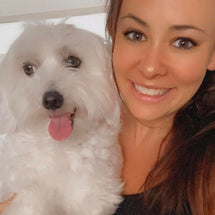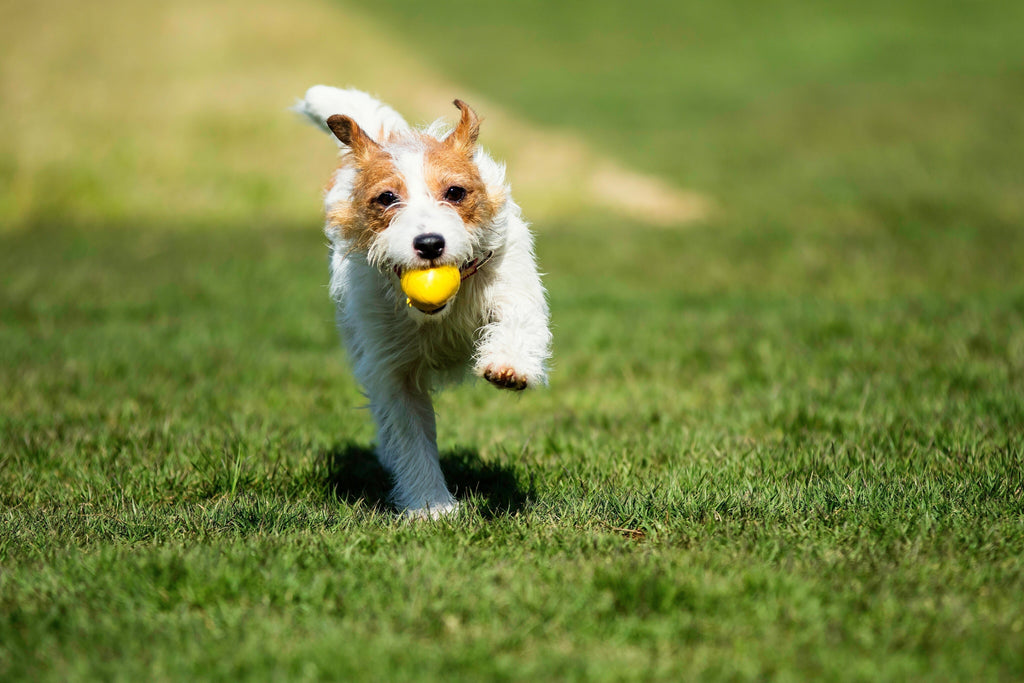Helping Overweight Dogs Thrive: A Guide to Achieving Optimal Weight Safely

Has your doggo gained a little weight?
Maintaining a healthy weight is crucial for the overall well-being and longevity of our beloved pets. However, we all know how challenging it can be to resist those puppy dog eyes: one dog treat here and there, and a few table scraps each night, but before you know it, your dog has gained a few extra kilograms.
What is a healthy weight?
Determining whether your dog is at a healthy weight involves various factors such as breed, age, size, and body composition. While breed standards often provide a general guideline, individual variations exist.
A dogs weight is typically assessed through body condition scoring, considering factors like rib and spine palpation, waist indentation, and overall muscle mass. This is often rated from 1-9 (1 being severely underweight, 5 being optimal and 9 being obese).
Start by visually inspecting your dog from above and from the side, looking for a visible waistline behind the ribs and a slight abdominal tuck. You should be able to feel your dog's ribs easily without applying too much pressure. Monitoring your dog's activity level and energy levels is also crucial, as a healthy weight dog should have good energy and be able to engage in regular physical activity without fatigue. Keep track of your dog's weight over time and watch for any significant changes, as sudden weight loss or gain could signal underlying health issues.
Signs of an overweight Dog:
Identifying signs of an overweight dog is crucial for maintaining their health and well-being.
-
Visual Inspection: When viewed from above, an overweight dog may lack a visible waistline, with the body appearing round or oval-shaped. From the side, the abdomen may sag or bulge rather than having a distinct tuck-up.
-
Rib Visibility: Feeling your dog's ribs can also indicate whether they are overweight. In an ideal weight dog, you should be able to feel the ribs easily without pressing too hard. If you need to apply significant pressure or can't feel the ribs at all, your dog may be overweight.
-
Difficulty Moving: Overweight dogs may exhibit signs of reduced mobility or stamina. They may tire more quickly during walks or playtime and may struggle to perform activities they once enjoyed.
-
Breathing Problems: Excess weight can put pressure on a dog's respiratory system, leading to difficulties breathing, especially during exercise or in hot weather. Wheezing, panting excessively, or laboured breathing can indicate a problem.
-
Joint Issues: Carrying excess weight can strain a dog's joints, leading to conditions like arthritis or hip dysplasia. If your dog seems reluctant to move, limps, or displays signs of discomfort when walking or getting up, it could be due to joint pain exacerbated by excess weight.
-
Changes in Behaviour: Overweight dogs may become less active and playful than usual. They may also show signs of irritability, depression, or reluctance to engage in physical activities due to discomfort or fatigue.
-
Difficulty Grooming: Obese dogs may struggle to groom themselves properly, leading to matting of the fur, skin infections, or hygiene issues. You may notice a decline in coat condition or an unpleasant odour due to inadequate grooming.
-
Digestive Problems: Some overweight dogs may experience digestive issues such as vomiting or diarrhoea, which can be exacerbated by dietary indiscretion or poor food choices.

Risks of Obesity
Studies have shown that an overweight dogs life expectancy is 2.5 years less than that of a dog with a healthy weight. As well as reduced life expectancy, obesity in dogs poses various other health risks:
-
Joint problems like (arthritis, Intervertebral disc disease, decreased mobility)
-
Respiratory issues
-
Cardiovascular disease
-
Diabetes mellitus
-
Weakened immune function
-
Skin and coat problems
-
Digestive disorders
-
Increased surgical risks
Causes of Overweight Dogs:
It is important to remember that weight gain occurs when the dog is less active than the number of calories they are consuming. Weight gain can also be attributed to a variety of factors, many of which are preventable with proper diet, exercise, and lifestyle management.
-
Overfeeding: Providing too much food or excessive treats can lead to overeating and weight gain in dogs. This is particularly common when owners offer food as a form of affection or in response to begging behavior.
-
Poor Diet: Feeding dogs high-calorie, low-nutrient foods or an imbalanced diet lacking essential nutrients can contribute to weight gain. Foods rich in carbohydrates and fats but low in protein and fiber can lead to excess calorie intake and weight gain over time.
-
Lack of Exercise: Inadequate physical activity and exercise can lead to a sedentary lifestyle, resulting in weight gain and decreased muscle mass. Dogs require regular exercise to maintain a healthy weight and overall well-being.
-
Genetics: Some dog breeds are more prone to weight gain and obesity due to genetic factors. Breeds such as Labrador Retrievers, Beagles, and Cocker Spaniels are known to have a higher risk of obesity.
-
Age: Older dogs may be more susceptible to weight gain due to a decrease in metabolism and activity levels. Senior dogs often require adjustments to their diet and exercise routine to prevent weight gain and maintain muscle mass.
-
Medical Conditions: Certain medical conditions, such as hypothyroidism, Cushing's disease, or insulin resistance, can predispose dogs to weight gain. These conditions may affect metabolism, hormone levels, or appetite regulation, leading to increased calorie intake and weight gain.
-
Desexing: Dogs that have been neutered or spayed may experience changes in metabolism and energy levels, making them more prone to weight gain if their diet and exercise routine are not adjusted accordingly.
-
Environmental Factors: Environmental factors such as a lack of access to outdoor space for exercise, living in a sedentary household, or being exposed to excessive heat or cold can contribute to weight gain in dogs.
Healthy Weight Loss Strategies:

Implementing healthy weight loss strategies for dogs involves a combination of dietary adjustments, increased physical activity, and lifestyle changes, though it is well worth it when you start to see your dog becoming more active, happier and you can even increase their average lifespan by up to 2.5 years!
-
Consult with a Veterinarian: Before starting any weight loss program for your dog, consult with your veterinarian to assess their current health status, determine their ideal weight, and develop a customised plan tailored to their needs.
-
Calorie Control: Measure your dog's food portions carefully and feed them an appropriate amount of high-quality, low-calorie food to achieve gradual weight loss. Avoid free-feeding and limit treats, as they can contribute to excess calorie intake.
-
Dietary Modifications: Switch to a diet that contain Low GI ingredients, complex carbohydrates and a high fibre content. Complex carbohydrates and higher fiber content helps your dog feel full while consuming fewer calories. Low GI ingredients are also beneficial to support blood sugar levels and sustained energy release. Consider incorporating fresh fruits and vegetables as low-calorie treats such as carrots, cucumber and broccoli!
-
Increase Physical Activity: Gradually increase your dog's daily exercise to help them burn more calories and improve their overall fitness. Aim for at least 30 minutes to one hour of moderate to vigorous activity each day, such as brisk walks, jogging, playing fetch, or interactive games.
-
Monitor Progress: Keep track of your dog's weight loss progress by regularly weighing them and assessing their body condition score. It is important to adjust their diet as they lose weight and exercise plan.
-
Slow, Gradual Weight Loss: Aim for a slow and steady rate of weight loss, typically 1-2% of body weight per week, to minimise the risk of health complications and ensure that the weight loss is sustainable in the long term.
-
Behavioral Modification: Address any underlying behavioral issues that may contribute to overeating or weight gain, such as food begging or scavenging. Establish consistent feeding and exercise routines, and provide mental stimulation through puzzle toys or enrichment activities to prevent boredom and emotional eating.
Managing your dogs weight through Diet

Managing an overweight dog through diet requires a balance between calorie control, nutrient balance, and portion management. Between 3-5% body weight per month is considered a safe weight loss. You should weigh your dog every 1-2 weeks and adjust your dog's portions as needed.
-
Measure out precise portions of food using a standard measuring cup and gradually reduce your dog's caloric intake to promote weight loss.
-
Increasing the fiber content of their diet can help your dog feel full and satisfied with fewer calories, so opt for high-quality dog foods with higher fiber content or add supplemental sources of fiber like canned pumpkin or green beans.
-
Limit high-calorie treats and table scraps, opting for low-calorie alternatives such as vegetables.
What is the best diet for my overweight dog?
The best diet for an overweight dog focuses on achieving gradual, sustainable weight loss while ensuring they receive essential nutrients for overall health and well-being.
-
High-Quality, Low-Calorie Dog Food: Choose a high-quality raw dog food or healthy dry dog food. These foods are typically lower in calories and fat, with higher fiber content to promote satiety while providing essential nutrients.
-
Increased Fiber Content: Look for dog foods with higher fiber content between 2.5 - 4.5% as fiber helps dogs feel full and satisfied with fewer calories. Fiber-rich ingredients like fruits, vegetables, and whole grains can aid digestion and promote weight loss.
-
Lean Protein Sources: Opt for dog foods that contain lean protein sources such as chicken, turkey, Kangaroo or fish. Protein is essential for maintaining muscle mass during weight loss and helps dogs feel satisfied between meals.
-
Healthy Treats and Snacks: Limit high-calorie treats and table scraps, opting for low-calorie alternatives such as carrots or green beans.






